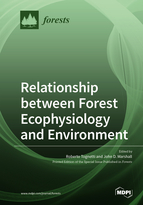Relationship between Forest Ecophysiology and Environment
A special issue of Forests (ISSN 1999-4907). This special issue belongs to the section "Forest Ecophysiology and Biology".
Deadline for manuscript submissions: closed (10 October 2020) | Viewed by 48105
Special Issue Editors
Interests: climate-smart forestry; forest ecophysiology; forest monitoring; biogeochemical cycles; resilience; mitigation; adaptation; biodiversity; forest restoration; disturbance
Special Issues, Collections and Topics in MDPI journals
Interests: biogeochemical cycles; carbon fluxes; nitrogen deposition; stable isotopes
Special Issues, Collections and Topics in MDPI journals
Special Issue Information
Dear Colleagues,
The goal of limiting the increase in global temperature gives forests a prominent role, mainly because they can be significant carbon sinks capable of removing carbon dioxide from the atmosphere. However, in addition to serving as carbon sinks, forest trees suffer from the negative impacts of climate change at certain points in time and in certain regions. These negative impacts include chronic water or heat stress and acute responses to strengthened disturbance events. Detecting how the intensification of disturbances and stresses will affect the trajectory of tree vulnerability (combination of a species exposure, resilience, and adaptive capacity to stress) is a major scientific challenge that requires the development of sensors to assess the resilience and tipping points of the three trillion trees on Earth.
In this Special Issue, we explore current research designed to assess thresholds for rapid tree decline and consequences associated with ecological change. In situ measurements of ecophysiological traits and time–series analysis of monitoring data are needed to reveal both subtle changes and abrupt deviations at appropriate spatial and temporal scales. A combined approach, involving innovative data collection and transmission methods, may provide an early warning system for trees operating beyond the normal or safe mode and may offer unique insights into ecological dynamics and physiological responses to climatic perturbations that are not represented by estimates of forest cover or biomass.
This Special Issue will comprise a selection of papers reporting recent advances in research on relationships between plant functions and the environment in natural forest ecosystems and in managed forest plantations. Original works and reviews are both welcome.
Prof. Dr. Roberto Tognetti
Prof. Dr. John D. Marshall
Guest Editors
Manuscript Submission Information
Manuscripts should be submitted online at www.mdpi.com by registering and logging in to this website. Once you are registered, click here to go to the submission form. Manuscripts can be submitted until the deadline. All submissions that pass pre-check are peer-reviewed. Accepted papers will be published continuously in the journal (as soon as accepted) and will be listed together on the special issue website. Research articles, review articles as well as short communications are invited. For planned papers, a title and short abstract (about 100 words) can be sent to the Editorial Office for announcement on this website.
Submitted manuscripts should not have been published previously, nor be under consideration for publication elsewhere (except conference proceedings papers). All manuscripts are thoroughly refereed through a single-blind peer-review process. A guide for authors and other relevant information for submission of manuscripts is available on the Instructions for Authors page. Forests is an international peer-reviewed open access monthly journal published by MDPI.
Please visit the Instructions for Authors page before submitting a manuscript. The Article Processing Charge (APC) for publication in this open access journal is 2600 CHF (Swiss Francs). Submitted papers should be well formatted and use good English. Authors may use MDPI's English editing service prior to publication or during author revisions.
Keywords
- Climate change
- Environmental disturbance
- Forest resilience
- Tree adaptation







